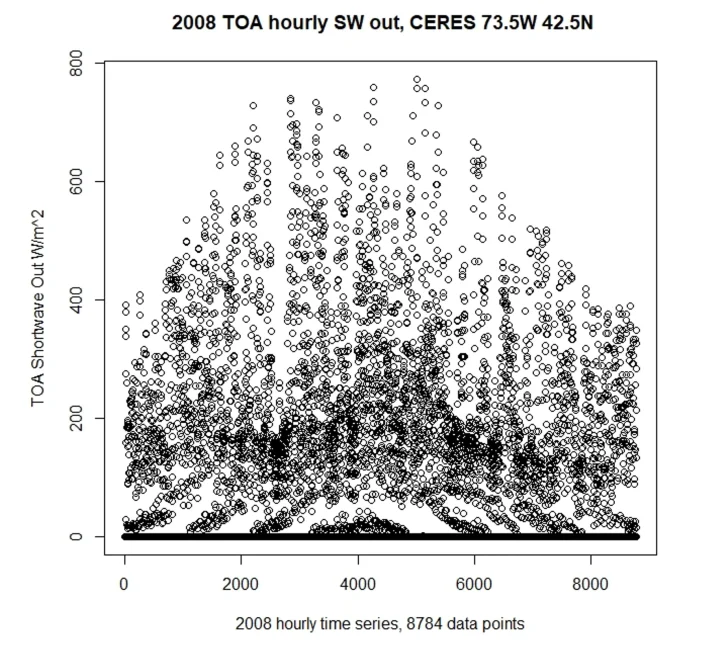Is there really a climate crisis? NASA Knew Better #NASA_Knew
David Dibbell
Looking toward space from the surface, the radiative warming effect of the atmosphere is a real thing in the static sense of absorption and emission of longwave energy by greenhouse gases (GHGs). But the atmosphere is not static. It is also the working fluid of its own dynamic heat engine operation, putting mass and stored energy into motion.
Consider that the attribution of warming on land and in the oceans to increasing concentrations of non-condensing GHGs could have arisen from too much emphasis on the static concept and too little on the observed dynamics. Must we expect heat energy to accumulate down here to harmful effect by what non-condensing GHGs do? That is how the problem statement is best framed.
To address this question, I refer to “Climate and Earth’s Energy Budget,” an article published January 14, 2009 on NASA’s EarthObservatory website. It is worth reading, to understand that both the static and dynamic aspects of the climate system are addressed. It is still available here: https://earthobservatory.nasa.gov/features/EnergyBalance
NASA expressed the static sense in the final paragraphs of that article, concluding with this: “However, as long as greenhouse gas concentrations continue to rise, the amount of absorbed solar energy will continue to exceed the amount of thermal infrared energy that can escape to space. The energy imbalance will continue to grow, and surface temperatures will continue to rise.”
But the dynamic nature of mass and energy flow had already been covered in earlier sections of the article about how the atmosphere and ocean work. Key quotes:
“The net heating imbalance between the equator and poles drives an atmospheric and oceanic circulation that climate scientists describe as a ‘heat engine.’”
So NASA understood this strong heat engine response, aside from the question of rising GHG concentrations. The global-scale circulation patterns in the atmosphere are the result.
“This coupled atmosphere and ocean circulation is known as Earth’s heat engine.
The climate’s heat engine must not only redistribute solar heat from the equator toward the poles, but also from the Earth’s surface and lower atmosphere back to space.”
So NASA also knew that the localized motions of the atmosphere are responses to absorbed energy and the resulting temperature differences. Heat engines run because there is a heat source, a heat sink, and a working fluid. Consider convective weather in this context, with its powerful updrafts to high altitudes.
“Satellite measurements indicate that the atmosphere radiates thermal infrared energy equivalent to 59 percent of the incoming solar energy.”
The total thermal radiation had already been given as 71 percent of incoming solar energy. So NASA knew that, by far, most of the longwave energy emitted to space is from the atmosphere itself. This means that analysis of rising GHG concentrations must consider what happens to the effectiveness of the working fluid as an emitter, and to the circulation rate. What happens to the effectiveness of surface emission directly to space through the “atmospheric window” would be less of a factor.
“At an altitude of roughly 5-6 kilometers, the concentration of greenhouse gases in the overlying atmosphere is so small that heat can radiate freely to space.”
So NASA knew that the “greenhouse effect” diminishes with altitude to the point that “heat can radiate freely to space.” This implies that circulation from the bottom half of the atmosphere to the top half matters greatly to the disposition of absorbed energy. 5-6 km is about at the 500 mb level, so about half the mass is below this altitude; global circulations reach much higher than that, and localized convective weather can top out at 15 km or more. The same non-condensing GHG molecules that absorb and emit looking down, also emit upward through the diminishing overlying mass of the atmosphere as altitude increases.
“The amount of heat a surface radiates is proportional to the fourth power of its temperature. If temperature doubles, radiated energy increases by a factor of 16 (2 to the 4th power). If the temperature of the Earth rises, the planet rapidly emits an increasing amount of heat to space. This large increase in heat loss in response to a relatively smaller increase in temperature—referred to as radiative cooling—is the primary mechanism that prevents runaway heating on Earth.”
So NASA knew better than to expect runaway climate conditions, based on the 4th power relationship of radiated energy to temperature. It is worth noting that the Earth is obviously not actually a single emitter. The figures in the article show a wide range of averaged radiative outputs over the surface of the planet. Hold that thought.
What else did NASA know? There are several references in the article to the CERES satellite measurements of outgoing longwave emission and shortwave reflection. (Note: this essay does not discuss the validity of using CERES data to estimate an overall planetary heat balance. That is a separate issue.)
In Figure 1, the observed TOA (top-of-atmosphere) outgoing longwave hourly values (in W/m^2) are plotted for all of 2008 for a mid-latitude 1 degree x 1 degree gridpoint near where I live. In Figure 2, the shortwave reflection is plotted for the same gridpoint. The shape of such plots varies from the tropics to the poles, but the point is the same: NASA knew that from space, each gridpoint is observed to perform as a highly active emitter/reflector. The variable output is not what one would expect from a passive radiative insulating layer. And if powered rather than passive, then it is the heat engine operation that must be driving this highly variable performance. Cloud variation, no doubt, resulting from the motion of the atmosphere, promotes this effect in respect to both longwave emission and shortwave reflection.
Figure 1. CERES hourly Syn1deg TOA observed longwave emission, W/m^2, for 73.5W 42.5N for all of 2008.

Figure 2. CERES hourly Syn1deg TOA observed shortwave reflection, W/m^2, for 73.5W 42.5N for all of 2008.
(The data plotted in figures 1 and 2 originates from this web portal, where the relevant citation statements are available: https://ceres.larc.nasa.gov/data/#synoptic-toa-and-surface-fluxes-and-clouds-syn )
Discussion
These plots illustrate that NASA knew that the planet, as observed from space, appears as a huge array of powered, highly variable emitter/reflector elements. They knew that the outgoing longwave energy from every location at every time interval originates from 4th-power radiative emission, mostly from the atmosphere itself. This is consistent with the heat engine nature of the atmosphere’s motion and the importance of altitude described in the article.
Still, NASA ended the article with emphasis on the static sense of what to expect: “The energy imbalance will continue to grow, and surface temperatures will continue to rise.” Why? Maybe this was to deflect potential objections, considering the obvious implications of the heat engine concept. Even so, the article presented the dynamic sense of the atmosphere’s operation for future readers to consider, and avoided the language of crisis or danger.
So do increased concentrations of non-condensing GHGs end up inhibiting the variable emission of longwave radiation to space? The actively powered emitter that matters most is at altitude, not at the surface, and altitude is not fixed. The heat engine motion of the working fluid supplies the energy from below. Down lower, the working fluid experiences an incrementally stronger radiative coupling of the atmosphere to the surface. This energy – the static GHG “forcing” – cannot be accumulated at the surface. It is much too easily transferred to the working fluid of the heat engine, to circulate to whatever altitude is needed. The mass flow rates will be whatever is required as the working fluid responds to the input of solar energy in real time and to its own stored energy. Just enough heat energy ends up being emitted back to space as longwave radiation, and just enough cloud activity reflects incoming sunlight to manage the energy input. Taken together, it is highly self-regulating as a dynamic response to surface temperatures.
Conclusion
Are we in a warming crisis due to non-condensing GHGs? The evidence of how the atmosphere works does not support such a claim. The minor incremental static warming effect from slowly increasing concentrations of GHGs is readily overwhelmed by the performance of the heat engine. The highly variable longwave emitter output and the active shortwave reflector performance observed from space provide direct evidence. At the time this article was written, NASA knew better than to use the language of crisis or catastrophe. They also knew that the static concept of GHG forcing/imbalance/rising surface temperatures would be misleading without the further explanation of the atmosphere and ocean circulations as dynamic responses to temperature differences.
David Dibbell
11-24-2021
Related
Source link
Author Guest Blogger







